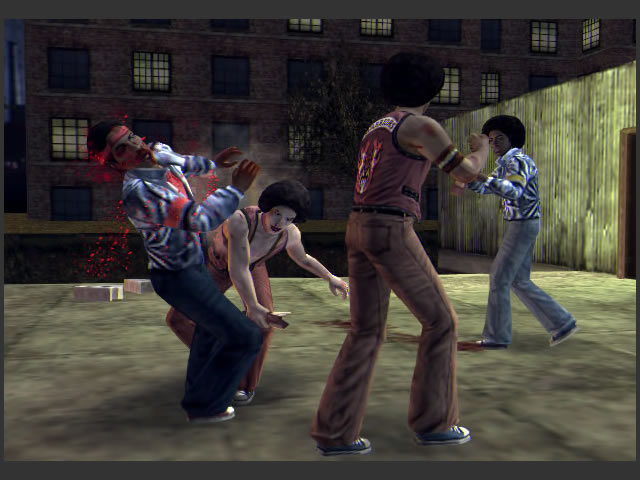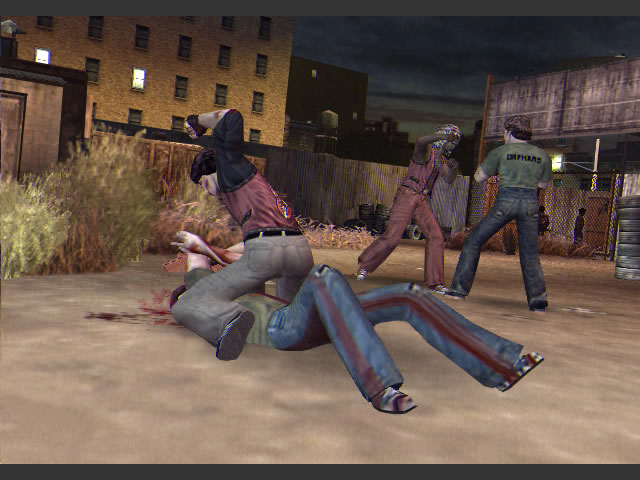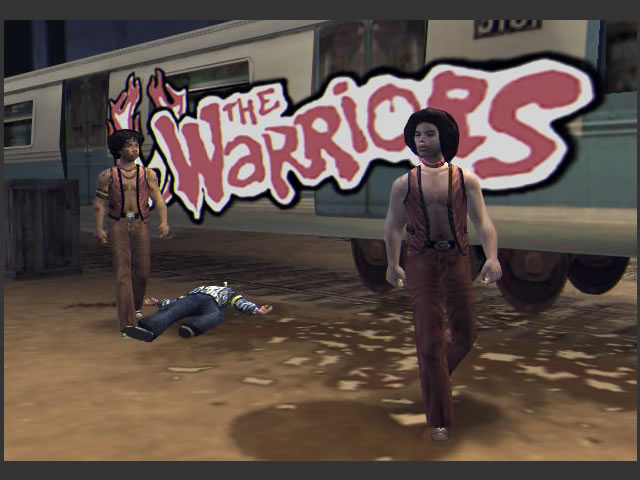Beat on the brats.
After Hot Coffee, most publishers would turn to the Light side and release a game about puppies, rainbows, or rainbow-colored puppies. Then again, most publishers don’t have the cajones of Rockstar, who punch you in the face again with a title full of unrepentant gang violence, drug use and F-bombs. The Warriors lives alongside the cult classic 1981 film by Walter Hill, a surprisingly great brawler that’s successful not only as a companion piece to the movie but as a recreation of the dingy, bankrupt New York of the late ’70s.
Instead of following the movie, the game’s plot largely charts a new path. Typically that’s a way around licensing restrictions, but not here. In fact, you get the idea that Rockstar could have made a game in which the Warriors were so into Star Wars that they spent all their time in cardboard Stormtrooper outfits and no one but Lucas would have complained.
So the game follows the gang in the three months leading up to the events of the film, then puts players square in the middle of the great dust-up depicted in the movie. It also chronicles the gang’s rise through a series of flashback missions. Through the generally linear plot, it creates a lively set of rivalries with outfits like the Orphans, the skinhead Turnbull ACs and the Baseball Furies, who perhaps over-emphasize the importance of the bat. There’s even an appearance by Chatterbox and the Hi-Hats, the movie’s absurd gang of mimes.
Despite the fact that the characters here are no more upstanding than those in GTA, they’re actually a lot more likable and fun. The good vibes stem from the group dynamic, much of which is due some excellent voice work and motion capture. (Though we doubt you’d hear ‘oh, snap’ or ‘get my XXXX on’ in the late ’70s.) Plus, skipping a free-roaming city in favor of a more typical mission set allows Rockstar to focus the development of the characters. Even if you haven’t seen the movie, within a couple hours all the faces will be familiar.
The whole context of running a street gang gives Rockstar plenty of leeway to create side missions as well. After each story mission, players return to the hangout on Coney Island, from which they can explore the neighborhood to win bonus items. These activities put the stealth mechanics to work; characters can hide in shadowy corners to evade pursuit. They also offer more opportunities to explore fun mini-games like lockpicking, car stereo thievery and graffiti.
Navigating through the game is generally a better experience than any of the studio’s previous efforts. Occasionally while running a character will get hung up on a jutting corner, but mostly it’s about smoothly tearing down alleys and over chainlink fences to evade cops and rival gangs. In a nice touch, you can fight other gangs without the cops intervening, which means there’s more random combat than would otherwise happen.
 Plenty of critics are extolling the virtues of the combat system with words like ‘deep’ and ‘adaptable’. I don’t think there’s any way to create true depth with only two attack buttons and a grapple, but The Warriors manages to deliver a lot of combat variation anyway. The moves are all context-sensitive; unleashing a powerful attack while grappling an opponent near a wall will do something totally different than it will when out in the open. The button combinations are easy to learn, which keeps you from having to dip into the pause menu when things get hairy. The Warriors may be limited to brutal (very brutal) beat-down combat, but it does the style better than any offering in recent memory.
Plenty of critics are extolling the virtues of the combat system with words like ‘deep’ and ‘adaptable’. I don’t think there’s any way to create true depth with only two attack buttons and a grapple, but The Warriors manages to deliver a lot of combat variation anyway. The moves are all context-sensitive; unleashing a powerful attack while grappling an opponent near a wall will do something totally different than it will when out in the open. The button combinations are easy to learn, which keeps you from having to dip into the pause menu when things get hairy. The Warriors may be limited to brutal (very brutal) beat-down combat, but it does the style better than any offering in recent memory.
What works best in the combat system is scale. In some situations, dozens of gang members will be swarming the screen. Sometimes it’s a free for all and sometimes they’re all after you, but in either case, targeting and attacking is largely free from difficulties. And when problems do arise – particularly of the irritating camera variety – they’re camouflaged by sheer numbers. After all, when twenty enemies are pressing in it doesn’t really matter who you hit, as long as you hit someone.
Having nine principal characters helps, too. Every one does something differently: Ajax is powerful as hell, Cleon is a great all-around fighter and Cochise throws down a little kung-fu. They all share the same commands, but since each moves at a different speed and has more or less power, there’s a lot to digest. It would have been great to choose who to play and when, but that choice is mostly left to the designers.
 Give them credit, though. The game might suffer from the sort of visual issues that have been a part of the GTA series – blocky models, limited textures and clipping problems – but it still manages to create totally convincing visions of nighttime New York. Coney looks just right and while some other neighborhoods are only recognizable in name, it all looks just like the city did back in those dark days.
Give them credit, though. The game might suffer from the sort of visual issues that have been a part of the GTA series – blocky models, limited textures and clipping problems – but it still manages to create totally convincing visions of nighttime New York. Coney looks just right and while some other neighborhoods are only recognizable in name, it all looks just like the city did back in those dark days.
The game is longer than the film, but a dedicated player will still take down the Story mode in a couple of days. The credits don’t roll there, though. Many cool bonuses are hidden in each level, and a great side-scrolling arcade game is unlocked after beating the Story mode once. There’s also the ability to run through the story co-operatively or dip into the huge Rumble mode, which presents a wide variety of Deathmatch, CTF and King of the Hill games for solo, co-op and multiplayer brawling.
The shocker is that every game mode feels totally at home in the world The Warriors creates. This isn’t as ambitious a game as some might expect from Rockstar, but it’s a much more cohesive one than we’re used to. Where San Andreas tried to be The Ghetto Godfather, The Warriors wants to be’well, it’s obvious, but Rockstar has actually pulled it off by creating a game that equals the movie’s cultish charm and, in some ways, surpasses it. If you don’t believe us, come out and play.
-
Great story and scripting
-
Simple but satisfying combat
-
Does justice to the film
-
Plenty of content
-
Visual issues
-
Predetermined characters
-
Camera gets a little wonky






